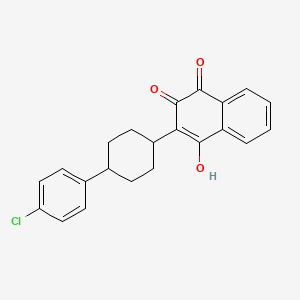Drug Information
Drug (ID: DG00976) and It's Reported Resistant Information
| Name |
Atovaquone
|
||||
|---|---|---|---|---|---|
| Synonyms |
ATOVAQUONE; 95233-18-4; Mepron; Wellvone; Acuvel; Atavaquone; 566C80; 94015-53-9; Mepron (antipneumocystic); cis-Atovaquone; 137732-39-9; BW 566C; 566C; C22H19ClO3; 3-[4-(4-chlorophenyl)cyclohexyl]-4-hydroxynaphthalene-1,2-dione; Atovaquone (Atavaquone); 2-(trans-4-(p-Chlorophenyl)cyclohexyl)-3-hydroxy-1,4-naphthoquinone; UNII-Y883P1Z2LT; UNII-F1W7QUV0KI; F1W7QUV0KI; 2-(4-(4-Chlorophenyl)cyclohexyl)-3-hydroxy-1,4-naphthoquinone; 2-[trans-4-(4-chlorophenyl)cyclohexyl]-3-hydroxy-1,4-naphthoquinone; 2-(TRANS-4-(4-CHLOROPHENYL)CYCLOHEXYL)-3-HYDROXY-1,4-NAPHTHALENEDIONE; Y883P1Z2LT; CHEBI:575568; 2-[trans-4-(4-chlorophenyl)cyclohexyl]-3-hydroxynaphthalene-1,4-dione; NSC-759582; NCGC00016961-01; CAS-95233-18-4; 2-[trans-4-(4-Chlorophenyl)cyclohexyl]-3-hydroxy-1,4-naphthalenedione; DSSTox_CID_2629; trans-2-[4-(4-Chlorophenyl)cyclohexyl]-3-hydroxy-1,4-naphthalenedione; DSSTox_RID_76664; DSSTox_GSID_22629; 2-(4-(4-Chlorophenyl)cyclohexyl)-3-hydroxynaphthalene-1,4-dione; 2-[trans-4-(p-Chlorophenyl)cyclohexyl]-3-hydroxy-1,4-naphthoquinone; 1,4-Naphthalenedione, 2-[cis-4-(4-chlorophenyl)cyclohexyl]-3-hydroxy-; 2-((1r,4r)-4-(4-chlorophenyl)cyclohexyl)-3-hydroxynaphthalene-1,4-dione; DRG-0084; BW 566C-80; Mepron (TN); BW-A 566C; HSDB 7083; SR-05000001438; BW-566C-80; CRL-8131 & Atovaquone; 2-[4-(4-chlorophenyl)cyclohexyl]-3-hydroxy-1,4-naphthoquinone; Atovaquone & Interleukin 12; 2-[4-(4-chlorophenyl)cyclohexyl]-3-hydroxy-naphthalene-1,4-dione; 2-[4-(4-chlorophenyl)cyclohexyl]-3-hydroxynaphthalene-1,4-dione; cis-2-(4-(4-Chlorophenyl)cyclohexyl)-3-hydroxy-1,4-naphthoquinone; Cis-2-[4-(4-chlorophenyl)cyclohexyl]-3-hydroxy-1,4-naphthoquinone; 1,4-Naphthalenedione, 2-(cis-4-(4-chlorophenyl)cyclohexyl)-3-hydroxy-; 2-(trans-4-(4-chlorophenyl)cyclohexyl)-3-hydroxynaphthalene-1,4-dione; trans-2-(4-(4-chlorophenyl) cyclohexyl)-3-hydroxynaphthalene-1,4-dione; ATO & IL-12; Atovaquone [USAN:USP:INN:BAN]; Atovaquone-[d5]; Atovaquone- Bio-X; BW 566C80; Spectrum_001743; starbld0018905; SpecPlus_000686; Prestwick0_000534; Prestwick1_000534; Prestwick2_000534; Prestwick3_000534; Spectrum2_001665; Spectrum3_000991; Spectrum4_001117; Spectrum5_001382; Atovaquone EP Impurity B; SCHEMBL21694; SCHEMBL21695; Atovaquone (JAN/USP/INN); BSPBio_000547; BSPBio_002681; KBioGR_001594; KBioSS_002223; Atovaquone Related Compound A; MLS002153863; BIDD:GT0849; DivK1c_006782; SCHEMBL637069; SPECTRUM1504210; SPBio_001849; SPBio_002468; BPBio1_000603; CHEMBL222334; CHEMBL471792; CHEMBL519462; GTPL9695; SCHEMBL1542719; SCHEMBL1649508; SCHEMBL9975142; SCHEMBL9975229; Atovaquone, >=98% (HPLC); CIS-ATOVAQUONE (RACEMIC); DTXSID7022629; CHEBI:95346; KBio1_001726; KBio2_002223; KBio2_004791; KBio2_007359; KBio3_001901; DTXSID20916694; BDBM192009; HMS1569L09; HMS1922F19; HMS2089M14; HMS2093C10; HMS2096L09; HMS2235N08; HMS3369N09; HMS3651N20; HMS3713L09; Pharmakon1600-01504210; AMY15339; BCP09477; Tox21_110714; 3-[4-(4-chlorophenyl)cyclohexyl]-4-hydroxy-naphthalene-1,2-dione; Atovaquone related compound A [USP]; CCG-39090; FD7252; MFCD00889188; NSC759582; s3079; STK636160; trans-2-[4-(4-chlorophenyl)cyclohexyl]-3-hydroxy-1,4-naphthoquinone; ZINC12504271; 1,4-Naphthalenedione, 2-(4-(4-chlorophenyl)cyclohexyl)-3-hydroxy-, trans-; 1,4-Naphthalenedione, 2-(trans-4-(4-chlorophenyl)cyclohexyl)-3-hydroxy-; 2-[4-(4-chlorophenyl)cyclohexyl]-3-hydroxy-1,4-dihydronaphthalene-1,4-dione; AKOS005567953; AKOS015895691; AKOS015961933; Tox21_110714_1; ZINC100017856; ZINC100345537; ZINC116473771; ZINC299873031; BW-556C-80; CCG-220534; DB01117; MCULE-7318126574; NSC 759582; NCGC00016961-02; NCGC00016961-03; NCGC00016961-04; NCGC00016961-06; NCGC00016961-07; NCGC00016961-11; NCGC00095113-01; NCGC00095113-02; AC-30251; AS-12809; Atovaquone 100 microg/mL in Acetonitrile; BA164228; HY-13832; SMR001233220; SBI-0052893.P002; AB00513855; FT-0602868; SW219222-1; A13708; C06835; D00236; F18448; J90007; AB00053222-03; AB00053222_04; AB00053222_05; 233A184; A853147; Q418179; SR-05000001438-1; SR-05000001438-2; SR-05000001438-4; SR-05000001438-5; Z1541632806; 2-[4-(4-chlorophenyl)cyclohexy]-3-hydroxy-1,4-naphthoquinone; 2-[4-(4-chlorophenyl)cyclohexyl]-3-hydroxy-1,4-napthoquinone; 2-[4-(4-chlorophenyl)cyclohexyl]-3-hydroxy-1.4-naphthoquinone; 2-Hydroxy-3-[4-(4-chlorophenyl)cyclohexyl]-1,4-naphthoquinone; 3-[4-(p-chlorophenyl)cyclohexyl]-4-hydroxy-1,2-naphthoquinone; 1,4-Naphthalenedione, 2-(4-(4-chlorophenyl)cyclohexyl)-3-hydroxy-; 2-[4-(4-Chlorophenyl)cyclohexyl]-3-hydroxynaphthoquinone, trans-; 3-[4-(4-Chlorophenyl)cyclohexyl]-4-hydroxy-1,2-naphthalenedione; 2-(cis-4-(4-Chlorophenyl)cyclohexyl)-3-hydroxy-1,4-naphthalenedione; cis -2-(4-(4-chlorophenyl)cyclohexyl)-3-hydroxynaphthalene-1,4-dione
Click to Show/Hide
|
||||
| Indication |
In total 1 Indication(s)
|
||||
| Structure |

|
||||
| Drug Resistance Disease(s) |
Disease(s) with Clinically Reported Resistance for This Drug
(1 diseases)
[1]
|
||||
| Target | Plasmodium Dihydroorotate dehydrogenase (Malaria DHOdehase) | PYRD_PLAF7 | [1] | ||
| Click to Show/Hide the Molecular Information and External Link(s) of This Drug | |||||
| Formula |
C22H19ClO3
|
||||
| IsoSMILES |
C1CC(CCC1C2=CC=C(C=C2)Cl)C3=C(C4=CC=CC=C4C(=O)C3=O)O
|
||||
| InChI |
1S/C22H19ClO3/c23-16-11-9-14(10-12-16)13-5-7-15(8-6-13)19-20(24)17-3-1-2-4-18(17)21(25)22(19)26/h1-4,9-13,15,24H,5-8H2
|
||||
| InChIKey |
BSJMWHQBCZFXBR-UHFFFAOYSA-N
|
||||
| PubChem CID | |||||
| ChEBI ID | |||||
| TTD Drug ID | |||||
| INTEDE ID | |||||
| DrugBank ID | |||||
Type(s) of Resistant Mechanism of This Drug
Drug Resistance Data Categorized by Their Corresponding Diseases
ICD-01: Infectious/parasitic diseases
| Drug Resistance Data Categorized by Their Corresponding Mechanisms | ||||
|
|
||||
| Key Molecule: Cytochrome b (CYB) | [1] | |||
| Molecule Alteration | Missense mutation | p.T268C |
||
| Resistant Disease | Falciparum malaria [ICD-11: 1F40.0] | |||
| Experimental Note | Identified from the Human Clinical Data | |||
| Experiment for Molecule Alteration |
Sanger sequencing analysis | |||
| Mechanism Description | Sequencing confirmed Tyr268Cys mutation in the cytochrome b gene, associated with atovaquone resistance, in isolates collected on days 29 and 34 and P. falciparum dihydrofolate reductase mutation Asn51Ile, associated with proguanil resistance in all successfully sequenced samples. | |||
| Key Molecule: Cytochrome b (CYB) | [1] | |||
| Molecule Alteration | Missense mutation | p.Y268S |
||
| Resistant Disease | Falciparum malaria [ICD-11: 1F40.0] | |||
| Experimental Note | Identified from the Human Clinical Data | |||
| Experiment for Molecule Alteration |
Sanger sequencing analysis | |||
| Mechanism Description | Sequencing confirmed Tyr268Cys mutation in the cytochrome b gene, associated with atovaquone resistance, in isolates collected on days 29 and 34 and P. falciparum dihydrofolate reductase mutation Asn51Ile, associated with proguanil resistance in all successfully sequenced samples. | |||
References
visits since 2022
If you find any error in data or bug in web service, please kindly report it to Dr. Sun and Dr. Zhang.
